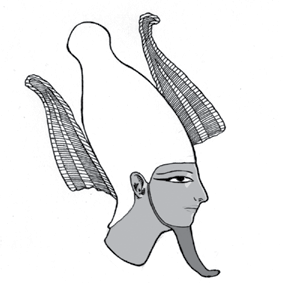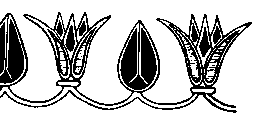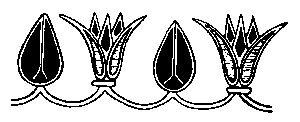Anubis Speaks!: A Guide to the Afterlife by the Egyptian God of the Dead (17 page)
Read Anubis Speaks!: A Guide to the Afterlife by the Egyptian God of the Dead Online
Authors: Vicky Alvear Shecter
Tags: #Spirituality, #History



headed serpent guarding the entrance to the next cavern. Look a little closer. There are fourteen human heads popping out of the snake’s body! They represent the moon’s path to fullness every month.
Why My People
Depicted the Divine with
Animal Heads
The three-headed snake with fourteen human
heads on its body is not so unusual. I’m sure you’ve noticed that most of us gods sport animal heads. And I’m sure you’ve been particularly admiring my noble jackal’s head on my exquisitely muscled human body. Why do I have a jackal head?
The better
to eat you with, my dear.
No, I am depicted with a jackal’s head for the same reason all the other Egyptian gods were shown as part beast. The ancient Egyptians understood that our greatness was indefinable and indescribable. Like the best in both man and nature, we were beyond the ordinary.
My people were keen observers of nature. After a time, they began to see certain animal behaviors as metaphors for the actions of the gods. For example, those who came to visit graveyards often saw desert jackals roaming nearby. This troubled them. Were the jackals protecting the dead? Or destroying them?
42


They began to see jackals as the representatives of the god of the dead—the god who had the power to both protect and destroy the dead. They began worshipping me because I had that kind of power, just like the jackals in the graveyard.
Similarly, nothing is more ferocious than a
mother lioness protecting her cubs. Sekhmet, the goddess of protection, displays that kind of rage and strength. Depicting her with a lion’s head was an acknowledgment of her power.
At times my people’s awe of nature turned into a deep respect for specific animals. Take cats for example. (
Please. Take them. Far away from me.
Seriously. I’m more of a dog person.
) My people appreciated how cats kept their granaries clear of mice. Eventually, they turned that gratitude into a special honor that saw cats as representations of Bast or Bastet, goddess of protection, pleasure, and cats (despite the fact that my cousins, the domesticated dogs, provided similar services and were infinitely less snobby, too. Just sayin’.).
I mean I loved my people, but I never understood their strange fascination with cats. And they took their passion to extremes, too, if you ask me, turning their affection into law. If a family’s house cat died, everyone in the home had to shave their eyebrows as a sign of mourning. If someone killed a cat—watch out—
the sentence was death. Of course, the death sentence 43



was the only part of the cat craziness that made sense to me.
The ibis was also sacred, as were certain bulls.
My people were in awe of the beauty, majesty, and even danger of many creatures. They had countless animals—including falcons, cats, snakes, crocodiles, baboons, bulls, ibises, and many others—mummified and offered as gifts to the gods.
Now that you understand our god-beast natures, it’s time to move on. We are nearing the end of this hour. Be sure to wave hello as we approach the three-headed-serpent-with-fourteen-human-heads-coming-out-of-its-back creature guarding the mouth of the next cavern. I’m sure glad that “lovely” monster is on our side!
44





